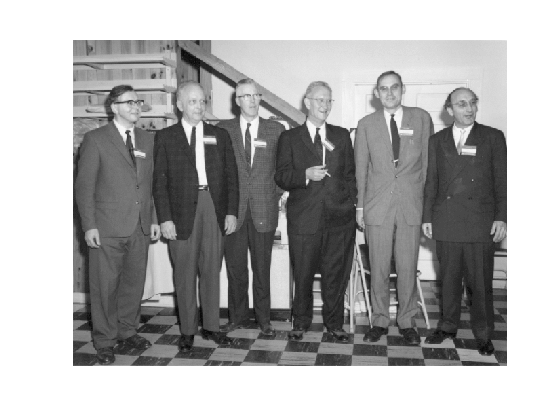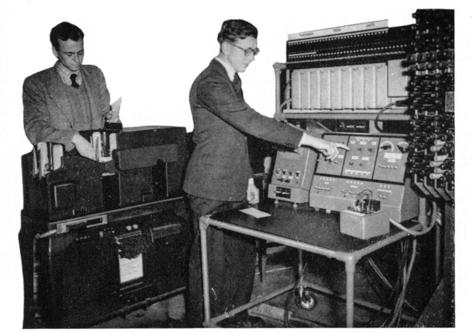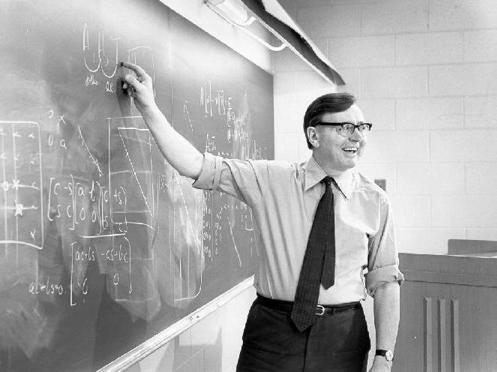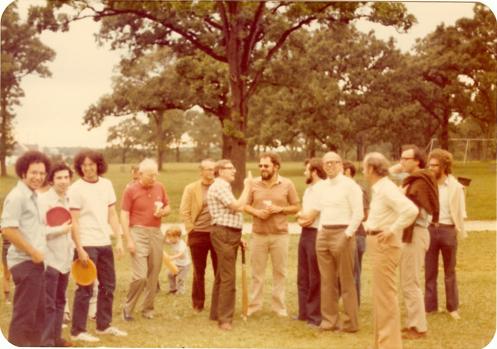Jim Wilkinson
I have already made several posts about gatlin, the image distributed with MATLAB of the organizing committee for the Gatlinburg III conference. From the MATLAB point of view, the first man on the left in the photo, J. H. Wilkinson, is by far the most important. From the early days of computers in the 1950s until his death in 1986, Wilkinson was the world's authority on matrix computation. His research on eigenvalue algorithms and their implementation in Algol led directly to EISPACK, the mathematical foundation for the first MATLAB.
Contents
load gatlin image(X) colormap(map) axis image axis off

Early Life
James Hardy Wilkinson was born in 1919 in Strood, England, a small town east of London, on the way towards Canterbury and Dover. The family owned a small dairy.
When Jim was only eleven years old he received a scholarship to Sir Joseph Williamson's Mathematical School in nearby Rochester. When he was barely 17, two years earlier than average, he entered Cambridge on a Trinity Major Scholarship in Mathematics. At Cambridge, his tutors included the famous mathematicians G. H. Hardy, J. E. Littlewood and A. S. Besicovitch. Besicovitch characterized Jim's performance on the Tripos exams, which are the culminatation of the undergraduate mathematics program at Cambridge, as "easily at the top of the First Class".
World War II
In the early years of World War II Wilkinson joined a team of mathematicians in an office at Cambridge. They computed trajectories of artillery shells using mechanical desk calculators. Later he transferred to a laboratory at Fort Halstead to work on the thermodynamics of explosions.
At Fort Halsead, he met Heather Ware, a mathematician from King's College. They soon married and lived happily together for over 40 years.
At the end of the war, Jim transferred to the National Physical Laboratory, where he would remain for the rest of his career. NPL is located just west of London, not far from Heathrow airport, and is like a British version of the American National Bureau of Standards.
Leslie Fox
One of Jim's colleagues at NPL, who became his lifelong friend, was Leslie Fox. Leslie was a year older than Jim, had been educated at Oxford, and returned there as a professor after eleven years at NPL. After Jim's death, Leslie wrote a 40 page biographical memoir for the British Royal Society. I am using that memoir as a reference for this blog.
I bring up Fox at this point because I was so impressed by his remark in the memoir that in their early days at NPL the two of them, together with E. T. Goodwin, solved an 18-by-18 set of simultaneous linear equations using desk computing equipment. It took them two weeks! It was one of the reasons they decided to build an automatic computer.
Pilot Ace
The famous mathematician Alan Turing was at NPL at the time and proposed the construction of a elaborate machine known as the Automatic Computing Engine, or ACE. Wilkinson became an assistant to Turing. After some disagreements with the Laboratory management, Turing departed for the University of Manchester and Jim was put in charge of the project. The team built only a portion of Turing's design, the Pilot ACE. Jim actually did some of the soldering. The Pilot ACE proved to be a useful machine on its own and was used for several years. A commercial version was produced by the English Electric Company under the name DEUCE.
Here is Jim at the console of the Pilot Ace, probably at its public debut in November 1950.

Ann Arbor
Beginning in the late 1950's, the University of Michigan offered a summer short course in computing. At first it was just one course, but it soon grew to be several courses in different aspects of computing -- programming, compilers, systems, numerical methods.
Bob Bartels was both a professor of mathematics and director of the University of Michigan computing center. Bob invited eminent numerical analysts to give the lectures in the numerical methods short course. Starting around 1958, Alston Householder and Jim Wilkinson were regular lecturers in the course and came to Ann Arbor for two weeks every summer.
In 1965, Bartels decided that running the computing center had become a full time job and that he had to give up his regular teaching duties. So the university recruited someone to replace him and I became an Assistant Professor of Mathematics at the University of Michigan in the fall of 1966. I also took over organizing the summer numerical methods short course. I was pleased that Alston and Jim continued to participate. Jim's notes for the Michigan summer course became the basis for his now classic 1965 book, The Algebraic Eigenvalue Problem.
Wilkinson and Householder knew all the restaurants in Ann Arbor, including the Pretzel Bell and the Old German, where the short course lecturers would usually order beer by the pitcher. Olga Taussky-Todd, who accompanied her husband John Todd to these dinners, had a fairly reserved manner. One day she planned to take a visiting friend to the Pretzel Bell for lunch and she asked Jim, "Is it possible to order beer in more modest quantities?" Jim replied, "Yes, but it has never been one of my ambitions."
Stanford
I took my first numerical analysis course in grad school at Stanford from George Forsythe in 1962-63. There were only a handful of students in the class. Forsythe was editor of the Prentice-Hall Series in Automatic Computation and was preparing Wilkinson's book Rounding Errors in Algebraic Processes for publication. He gave us the galley proofs to both read as course notes and check for typographical errors. Forsythe was a fastidious editor, so I suspect the class did not find any typos that he had not already caught.
Sometime after I left Stanford in 1965 Wilkinson was appointed to a part time professorship there. He visited perhaps one quarter a year. I'm not sure if he ever taught a regular course. He was a terrific lecturer for a seminar or a short course and wonderful in one-on-one discussions, but he was never anxious to be a full time academic.
Handbook
Much of Wilkinson's research was published in a series of papers in the journal Numerische Mathematik in the late 1960's. The papers described algorithms for matrix computation and included programs in Algol 60, the International Algorithmic Language. A number of other authors contributed papers and programs to the series, which was known as the Handbook Series.

All of the papers in the Handbook Series were eventually collected in an actual handbook, edited by Wilkinson and Christian Reinsch, and published by Springer-Verlag in 1971. Even today this Wilkinson and Reinsch handbook remains an important resource for work in matrix computation. The Algol codes provide a readable description of the techniques that lie at the heart of the matrix library in MATLAB.
Argonne
Argonne National Laboratory is a located in a forest preserve 25 miles southwest of Chicago. A herd of white deer roam freely on the grounds. The laboratory carries out a program of primarily unclassified research for the U.S. Department of Energy on basic science, energy, transportation, environmental issues, computing and national security.
Very few people could actually run the programs in the Handbook because very few computer centers had Algol compilers. Around 1970, the Mathematics and Computer Science Division, MCS, at Argonne began a project to translate a portion of the Handbook into Fortran, and to study the subsequent testing, distribution and support of the software. The project involved the subset of the Handbook devoted to eigenvalue computation because most computer center libraries already had satisfactory linear equation solvers, but few had the new eigenvalue methods that Wilkinson and colleagues had developed.
The project was called NATS, National Activity to Test Software. It was supported by the National Science Foundation and what was then called the Atomic Energy Commission. The stated objective of the project was research into the software development, testing and distribution process. The software itself, which became known as EISPACK, for Eigensysem Package, was just a byproduct. Simply writing good software wasn't regarded as supportable research. It wasn't in 1970, and still isn't in 2013.
Jim was an important participant in the NATS/EISPACK project. He visited Argonne at least once a year, usually after the Michigan summer course. He didn't write any Fortran code, but he was an active consultant in the process of rewriting what was mostly his Algol. And, the testing process in those days was more complicated because there were so many machines with different arithmetic behavior.

If you were involved in mathematical software back then, Argonne was the place to visit. I moved to the University of New Mexico in 1972 and came to Argonne for most of every summer. (When I walked in, Jim Boyle would say, "Moler is here, it must be June.") There were always lots of international visitors. In addition to Wilkinson, there were many other Brits. MCS had a close connection with NAG, the Numerical Algorithms Group in the UK. At the annual picnic one summer, we got the NAG chaps to play softball. That resulted in a challenge to try cricket and they brought the necessary equipment with them the next summer. Jim was a cricket connoisseur. He gave us a lecture on cricket strategy at the same blackboard he is using in the photo above. A day or two later at the next picnic, he continued the lecture. Jack Dongarra found this faded color photo in one of his shoe boxes.

The EISPACK project was followed by the LINPACK project, also centered at Argonne. These two projects motivated the first MATLAB. Wilkinson wasn't directly involved in MATLAB, but he certainly was the primary source of the algorithms that formed its original mathematical core.
References
[1] Leslie Fox, James Hardy Wilkinson, Biographical Memoirs of Fellows of the Royal Society 33 (1987): 669-708. https://royalsocietypublishing.org/doi/pdf/10.1098/rsbm.1987.0024.
[2] Nick Higham's Gallery of Wilkinson Photos, <http://www.maths.manchester.ac.uk/~higham/photos/wilkinson/index.htm>.
[3] History of Householder Symposia, <>.
- 범주:
- People









댓글
댓글을 남기려면 링크 를 클릭하여 MathWorks 계정에 로그인하거나 계정을 새로 만드십시오.